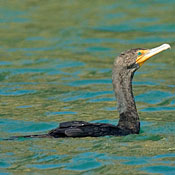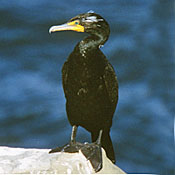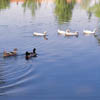Double-crested Cormorant
Phalacrocorax auritus

Upright Perching Water Birds

Length: 32 in. (81 cm )
A common species on inland lakes, rivers and ponds, it is also found in coastal habitats. It is regularly seen roosting near the water on trees, snags, beaches and rocky cliffs with its wings hanging open to dry in the sun. The cormorant has adaptations to the eyes to see underwater, and it uses its fully webbed feet to propel itself at great speeds in pursuit of the fish on which it relies heavily. This species nests in large colonies in trees or on the ground. The platform nest is made of twigs, sticks and aquatic vegetation.
The four-digit banding code is DCCO.
Bibliographic details:
- Article: Double-crested Cormorant
- Author(s): Dr. Biology
- Publisher: Arizona State University School of Life Sciences Ask A Biologist
- Site name: ASU - Ask A Biologist
- Date published: 13 Jul, 2017
- Date accessed: 18 October, 2025
- Link: https://askabiologist.asu.edu/activities/bird/double-crested-cormorant
APA Style
Dr. Biology. (Thu, 07/13/2017 - 15:36). Double-crested Cormorant. ASU - Ask A Biologist. Retrieved from https://askabiologist.asu.edu/activities/bird/double-crested-cormorant
Chicago Manual of Style
Dr. Biology. "Double-crested Cormorant". ASU - Ask A Biologist. 13 Jul 2017. https://askabiologist.asu.edu/activities/bird/double-crested-cormorant
MLA 2017 Style
Dr. Biology. "Double-crested Cormorant". ASU - Ask A Biologist. 13 Jul 2017. ASU - Ask A Biologist, Web. https://askabiologist.asu.edu/activities/bird/double-crested-cormorant
Be Part of
Ask A Biologist
By volunteering, or simply sending us feedback on the site. Scientists, teachers, writers, illustrators, and translators are all important to the program. If you are interested in helping with the website we have a Volunteers page to get the process started.








